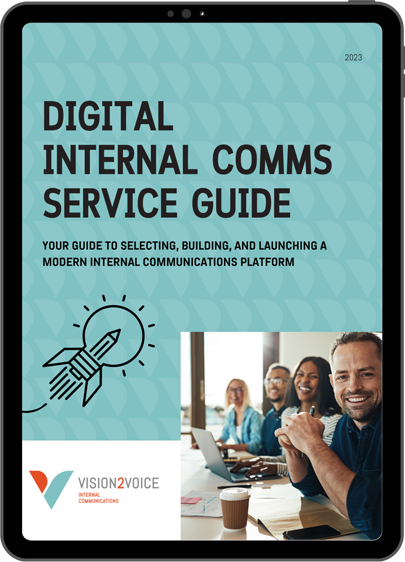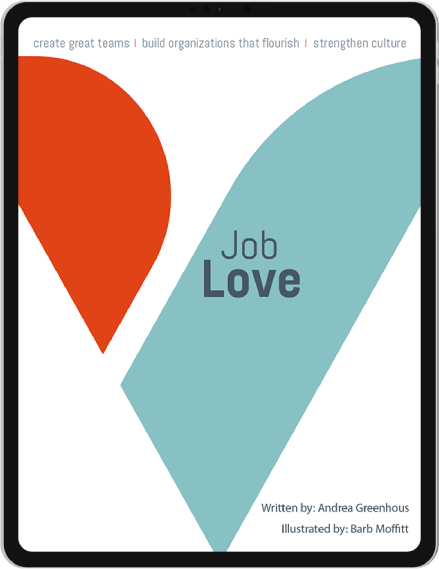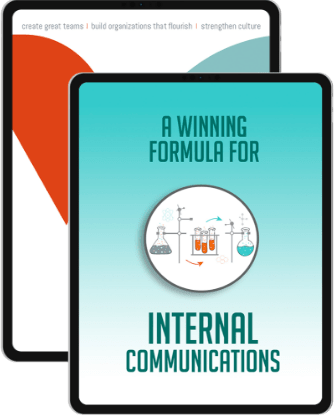Organizations need their employees now more than ever. But when employees aren’t empowered, they’re unable to reach their full potential—hindered from being productive, sharing innovative ideas, and unleashing their talent and passion.
Agency Defined
Agency is the ability to make decisions, take action, and influence outcomes in one’s job or organization. It involves control, autonomy, and influence. When people have agency, they can be proactive and productive, innovative and improve the world around them, and emotionally connected to their work. Agency improves our well-being (as anyone who has been micromanaged can confirm!).
There’s a problem – and we are part of it
The problem is myths about employee communication often strip them of their agency, keeping them in the dark, making them dependent on others, slowing down the work, and sucking the life out of people. We’ve worked with almost 100 organizations over 25 years and we’ve seen time and again how these myths have slowed progress, created barriers to change, and held employees back.
Here are five employee communication myths that need to change:
Myth: “Keep It Short”
The Truth: Conventional wisdom often says to keep communication short because “people won’t read it.” But when employees are trying to complete a task, they’re not looking for brevity—they’re looking for clarity. Detailed, step-by-step instructions or comprehensive information can be exactly what employees need to feel confident and capable. Skipping over critical details leaves employees confused, frustrated, and unable to complete their work effectively.
How This Strips Employees of Their Agency: When communication lacks the depth employees need, it undermines their ability to act with confidence and make informed decisions. Without access to the right information in the right format, employees are left feeling unsupported and disconnected.
What to Do Instead: Take the time to deeply understand the needs of different employee groups. Use data, feedback, and insights to determine what information they require and how best to deliver it. Instead of shortening it, make it easy to read by stripping it of unnecessary language and using formatting tricks like bullets and lots of headings. Tailor communication to include the right level of detail for the task at hand, balancing thoroughness with accessibility. This ensures employees feel empowered to act, solve problems, and succeed.
Quick story: We learned this lesson the hard way. We were involved in a major transformation project and decided to develop a guidebook for a new process. Our first draft was a crisp 15 pages. The problem was that we’d stripped the guide of key details. Our second draft was 65 pages – BUT the feedback from users was that it answered all their questions and provided the details they needed! When I walked down the hall of that particular unit, the team couldn’t stop talking about how the guide made a difference (hugs were also involved!) Sometimes more is more.
Myth: “Intranets Are Dead”
The Truth: Intranets have gained a reputation for being outdated or irrelevant, but the reality is that a well-organized, thoughtfully designed intranet is a powerful tool for empowering employees. When an intranet is intuitive, with clear navigation and relevant, easy-to-find information, it becomes an essential resource that helps employees complete tasks quickly and efficiently.
How This Strips Employees of Their Agency: Neglecting or dismissing the intranet deprives employees of a centralized hub for key resources. Without it, they spend valuable time searching for answers or bypassing formal processes, leading to frustration and inefficiency.
What to Do Instead: Focus on creating an intranet that meets employee needs. Develop user personas to better understand how different groups interact with the platform. Use user testing to refine functionality and organization. And most importantly, ensure the intranet evolves alongside the workforce by gathering regular feedback and making updates that reflect their priorities. When done right, the intranet becomes a cornerstone of employee empowerment.
Quick story: We’ve successfully used intranet content as a key resource for major transformation in organizations by creating dedicated microsites with all the information employees need to navigate a change. One client was moving over 1000 employees to a new manufacturing facility, and this complex move was made easier with detailed information, including timelines, packing and move instructions, and information about the new building. This was proven to be a key resource accessed by the majority of people involved in the move and the change was successful.
Myth: “We’re the Gatekeepers”
The Truth: The role of internal communication isn’t to protect employees or decide what employees should know—it’s to empower them with the information they need. Assuming that leadership or communicators alone can determine what’s relevant creates blind spots. Different groups across the organization have unique needs, and what’s crucial for one team may be entirely different for another.
How This Strips Employees of Their Agency: When communicators act as gatekeepers, employees lose access to the full context they need to make decisions and take ownership of their roles. This limits their ability to contribute effectively and feel connected to the organization’s goals.
What to Do Instead: Shift from being a gatekeeper to a guide. Take the time to understand the diverse needs of different employee groups by gathering feedback, observing patterns, and mapping content to their priorities. Then, use your communication expertise to organize and present information in a clear, accessible, and straightforward way. This is the superpower that enables employees to thrive.
Quick story: We often talk about the Goldilocks effect in employee communication. This idea is that, like Goldilocks, we need to tailor information to employees so that is ‘just right.’ This recognizes that a one-size-fits-all all approach, fits no one. The solution is to provide multiple layers of information around a topic – from a quick summary to a deep dive with something in between. This makes sure that Goldilocks finds the right content for them.
Myth: “Everyone Knows”
The Truth: It’s easy to assume that key information has reached employees simply because it’s been shared once or because “it’s common knowledge.” In reality, employees often juggle multiple priorities and may miss critical updates or fail to understand their relevance. Effective communication requires consistent reinforcement and tailoring messages to ensure they resonate with different audiences. And never forget new employees who are trying to drink through the firehose and catch up and learn the key things they need to know.
How This Strips Employees of Their Agency: When employees lack the information they need to make informed decisions, they feel uncertain and disconnected. This not only diminishes their ability to contribute meaningfully but also fosters a sense of exclusion from important organizational conversations.
What to Do Instead: Never assume. Communicate key messages using multiple channels and prioritize clarity and accessibility. Ensure the content is on your intranet and easy to find for anyone who is new or ‘missed the memo.’ Encourage feedback to ensure understanding and empower employees by equipping them with the context and resources they need to succeed.
Quick story: Early in my consulting career, clients would tell me that ‘everyone knows what that means’ and I’d believe them. Only to find out later that what I had assumed people knew, they didn’t. After a few embarrassing incidents, I’ve learned to never assume people know–even if it is something as simple as an acronym.
Myth: “We Already Know What Employees Think”
The Truth: Organizations often rely on data from outdated surveys or one-time feedback sessions to gauge employee sentiment. While these tools can provide useful insights, they’re not enough to capture the evolving realities of employees’ experiences. Work environments, team dynamics, and individual needs are constantly changing. Assuming you already know what employees think can lead to disconnects between leadership and the workforce.
How This Strips Employees of Their Agency: When employees feel that their voices are no longer valued because “the organization already knows,” they may stop sharing insights or raising concerns. This creates a culture where employees feel powerless to influence decisions or improve their work environment.
What to Do Instead: Commit to ongoing listening efforts, including regular pulse surveys, open-door policies, anonymous feedback channels, and meaningful one-on-one conversations. Remember: listening is only the first step; acting on what you hear solidifies trust and empowerment.
Quick story: in our audits, we often discover this gap. Several years ago, we audited an organization with a large population of workers who were on the front lines. The communication team had assumed that this group wasn’t interested in the organization’s strategy and what was happening in the industry. The audit proved otherwise. The CEO and his senior leadership team were thrilled to learn that employees wanted to better understand the company strategy so they could contribute to the success of the organization.
Start Letting Go
Giving employees agency starts with understanding that no one wants to be in the dark or spend hours looking for the information they need. It triggers a threat response, and our focus shifts to survival instead of thinking strategically, creatively or applying our brains.
The next step is to recognize the myths that hold us back and changing our mindset. Because when we use our skills and expertise, we can give employees what they really want: agency.
We can help
Vision2Voice has the expertise and fresh ideas to help you let go of the myths robbing your employees of agency. Connect with us for a free 15-minute session. We can talk through employee communications issues or explore opportunities to strengthen your strategy.






